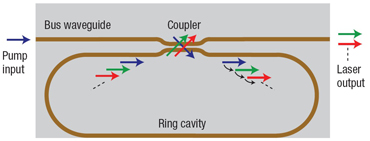
| Home | About Us | Contribute | Bookstore | Advertising | Subscribe for Free NOW! |
| News Archive | Features | Events | Recruitment | Directory |
| FREE subscription |
| Subscribe for free to receive each issue of Semiconductor Today magazine and weekly news brief. |
News
28 February 2008
Going long with silicon Raman cascades
Researchers at Intel have reported the construction of an optically pumped silicon laser that emits infrared light at a wavelength of 1848nm (Nature Photonics, Advanced Online Publication, 24 February 2008, doi:10.1038/nphoton.2008.4). Although silicon Raman lasers have been created previously (since about 2004), this is the longest wavelength produced so far, achieved using a double Raman red-shift (also known as a Stokes shift). The output power is more than 5mW and the line-width is less than 2.5MHz (the frequency of 1848nm infrared is about 160THz). The scientists are hopeful that future devices could emit in the mid-infrared of 2000-5000nm (2-5 microns) range.

Image: Schematic of silicon Raman laser configuration.
These longer infrared wavelengths can be used to sense trace gases, monitor environments and perform biomedical tests. Further possible applications cited include industrial process control and free-space communication. These applications need higher-quality radiation compared with current semiconductor technology and are usually carried out using solid-state lasers, which are bulkier and more difficult to operate. The Intel group hopes to be able to develop low-cost, compact, room-temperature, high-performance mid-IR lasers for such work.
The Nature Photonics paper describes the use of the laser to perform rotationally resolved direct absorption spectroscopy on the gas molecules methane and water vapor. The measurement of methane levels is an important aspect of monitoring greenhouse gases; atmospheric water content is important to Intel as this level needs to be tightly controlled to achieve high production yields in CMOS semiconductor processing.
The laser device uses the Raman effect, where a material absorbs light at one wavelength and emits at a longer wavelength, leaving some vibrational energy in the material. In fact, the effect is used twice in a cascade, moving the source radiation at 1550nm successively to 1686nm and then 1848nm. A third cascade would take the wavelength to 2045nm. Numerical modeling at Technische Universitaet Hamburg-Harburg has suggested that Raman silicon lasers could use cascades up to the sixth order. With the 15.6THz Raman red-shift quoted in the paper, the sixth-order wavelength would be about 3000nm (3 microns).
The longer wavelengths could also benefit from the absence of two-photon absorption in silicon beyond 2.2 microns. Silicon also has high Raman gain with narrow gain-bandwidth. The material is optically transparent at these infrared frequencies and up to a wavelength of 6 microns. Low-loss silicon-on-insulator waveguide technology allows the creation of tight optical confinement, resulting in low thresholds for lasing. Semiconductor production technology allows the integration of CMOS electronics and would avoid the complex assembly and alignment procedures needed for solid-state lasers. All these features suggest that silicon could be at an advantage over silica-based Raman and solid-state laser technologies.
The laser cavity was produced as a rib waveguide in a ring or ‘race track’ formation (pictured). The straight waveguide light-path from the pump to the output is directionally coupled to the cavity. A tunable continuous-wave laser (with a wavelength of 1550nm) was used as the pump. Lasers with such wavelengths have been widely developed for use in optical communications.
The pump laser power threshold for the first-order lasing (1686nm) is 80mW and for the second-order (1848nm) it is 120mW. Between these powers, the slope efficiency (rate of increase of laser output) is ~6%. The second-order slope efficiency is measured at 2.7%.
The researchers believe that improvements could be sought by optimizing the coupling coefficients of the pump and signal wavelengths. Other cavity configurations, such as using Bragg gratings as cavity reflectors, could also be tried.Intel demos first 40GHz hybrid InP/silicon laser
First electrically pumped hybrid silicon laser
Search: Silicon laser
Visit: http://origin.www.nature.com
The author Mike Cooke is a freelance technology journalist who has worked in the semiconductor and advanced technology sectors since 1997.